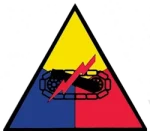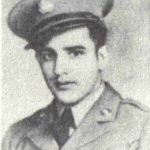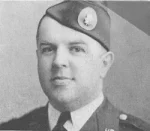1st Lt. James Rowe Cleland was born in Illinois on May 4, 1923, to Dewitt N. Cleland and Margaret A. Rowe-Cleland, and had an older sister. The family resided at 2102 South Tenth Avenue, Maywood, Illinois, and Jim graduated from Lincoln School and later Proviso Township High School in 1940. After high school, he attended Northwestern University for two years before he enlisted in the US Army on April 8, 1942, and was issued the serial number 16 077 697.
Because of his scores on the Army General Classification Test, he qualified to attend Officer Candidate School. He successfully completed OCS and was commissioned a second lieutenant. His serial number was O 747 214. He was then trained as a pilot. It is known that he trained at Gowen Army Airfield located near Boise, Idaho starting on July 28, 1943. From there on September 1, 1943, he trained at Scottsbluff Army Airfield in Nebraska, where he was assigned to the 462nd Bomb Squadron. It is known that he piloted a B-24.
It is not known when, but Jim was reassigned to the 740th Bomb Squadron, 455th Bomb Group which had activated on June 1, 1943. It appears he was assigned to the squadron as they prepared to go overseas. They arrived in Italy in January and February 1944. His squadron bombed factories , railroad yards, oil refineries, storage areas, ports and airfields in Poland, France, Germany, Italy, Hungary, Czechoslovakia, and Austria.
On February 25, 1944, his squadron was on what was Jim’s and his crew’s last mission. The squadron left San Giovanni Field on a combat mission. Jim’s plane’s number was 42-52210. Other pilots from his squadron gave statements about the incident. At about 36 minutes from the target, 2nd Lt. James Austin stated that Jim dropped his bomb load. It appears that Jim’s plane was having some sort of mechanical issue and he was attempting to lighten his plane. According to another statement given by Austin, the formation was about 30 minutes from the target and Jim’s plane was in formation for about five minutes before he pulled his plane back and left the formation. Jim flew his plane for a few minutes opposite the formation and lost altitude. He then tagged on to another formation. It appeared to Austin that Jim’s plane was at 18,000 feet and attempted to turn back.
2nd Lt. Robert Beckner said that Jim’s plane was about 5,000 feet below the other planes that were at 22,000 feet which was the bombing altitude. The planes were about 20 minutes from the target. Jim’s plane was reported by him to be lagging behind the rest of the formation, but looked like he was attempting to catch up. At about 15 minutes from the target Jim appeared to have made the decision to leave the formation and return to base. the plane was last seen at 1100 hours which was the last time Jim and his crew were seen alive. It is not known what happened, but Jim’s plane did not return from the mission and reported missing somewhere in the area of Graz, Austria.
His father received a telegram from the War Department.
MR DEWITT CLELAND
131 SOUTH EUCLID AVENUE
OAK PARK ILLINOIS
THE SECRETARY OF WAR DESIRES ME TO EXPRESS HIS DEEP REGRET THAT YOUR SON 2ND LIEUTENANT JAMES R. CLELAND HAS BEEN REPORTED AS MISSING IN ACTION SINCE THE TWENTY FIVE FEBRUARY OVER AUSTRIA PERIOD IF FURTHER DETAILS OR INFORMATION ARE RECEIVED YOU WILL BE PROMPTLY NOTIFIED PERIOD
ULIO
Official: THE ADJUTANT GENERAL
A letter followed the telegram.
Mr. DeWitt Cleland
131 South Euclid Avenue
Oak Park, Illinois
Dear Mr. Cleland:
This letter is to confirm my recent telegram in which you were regretfully informed that your son, Second Lieutenant James R. Cleland, O, 747, 214, Air Corps, has been reported missing in action since 25 February 1944 over the European Area.
I know that added distress is caused by failure to receive some information or details. Therefore, I wish to assure you that at any time additional information is received it will be transmitted to you without delay, and, if in the meantime no additional information is received, I will again communicate with you at the expiration of three months. Also, it is the policy of the Commanding General of the Army Air Forces upon receipt of the “Missing Air Crews Report” to convey to you any details that might be contained in that report.
The term “missing in action” is used only to indicate that the whereabouts or status of an individual is not immediately known. It is not intended to convey the impression that the case in closed. I wish to emphasize that every effort is exerted continuously to clear up the status of our personnel. Under war conditions this is a difficult task as you must readily realize. Experience has shown that many persons reported missing in action are subsequently reported prisoners of war, but as this information is furnished by countries with which we are at war, the War Department is helpless to expedite such reports. However, in order to relieve financial worry, Congress has enacted legislation which contains in force pay, allowances and allotments to dependents of the personnel being carried in a missing status.
Permit me to extend to you my heartfelt sympathy during this period of uncertainty.
Sincerely yours,
(signed)
J. A. ULIO
Major General
The Adjutant General.
In July 1945, the entire plane crew was declared dead. His father was sent a letter telling him of the finding of death in his son’s case. It was not until after the war that Jim’s rank was corrected to first lieutenant.
The American Graves Registration Service had the job of recovering the dead after the war. Reports from the German Luftwaffe stated that on February 25, 1944, a B-24 Liberator was downed by its pilots at about 12:15 pm at Trahuetten, about 8.69 miles west of Deutschlandsberg, Germany. The names and serial numbers of six of the dead crew members listed. All the men were buried in a mass grave in the Trakuetten Cemetery. When the AGRS team arrived in the town, the grave was found with a marker that read, “10 American Flyers 25.2.44.” From interviews conducted with the residents by the AGRS, the team concluded that the only Americans buried in the grave were members of the crew from plane #42-52210. Another American buried in the cemetery, on April 2, 1944, was in a isolated grave and was identified by his id tags.
What is known is that the remains of Jim’s crew were recovered and buried, in separate graves, in the United States Military Cemetery, St. Avold, Moselle, France. Attempts were made to identify the men through the use of dental records. Two of the crew members, Sgt. Clark and S/Sgt, Snavely were identified by dental records. When this was determined not to be successful for the other members of the crew, the decision was to return the remains to the United States. 1st Lt. James R. Cleland was buried in a grave, with the other members of his air crew, at the Grafton National Cemetery, Grafton, West Virginia, on April 14, 1950, in Section A, Site 4. The site was chosen so that all the families would have approximately the same distance to drive to visit the grave.






